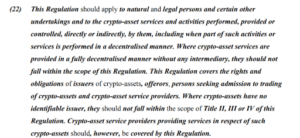Way to stop crypto hack? Make them reversible

What if an immutable and irreversible cryptocurrency transaction wasn’t?
That’s the idea trio of Stanford University researchers proposed this week as a way to combat the seemingly constant string of thefts, scams and hacks that have routinely seen hundreds of millions of dollars stolen in the crypto industry — including more than $14 billion last year alone.
Specifically, Kalli Jenner, Dan Boneh, and Qinchen Wang have proposed a reversible version of ether and NFT tokens that would give token owners a short window when they could appeal to a decentralized panel of judges who could only freeze and reverse the transaction if they believed was appropriate.
The proposal would not replace standard immutable ether or NFT tokens; it would simply add a reversible standard crypto project developers could choose to use instead.
“The immutability of blockchain transactions is both a blessing and a curse,” Jenner wrote in a post describing the project. Pointing to thefts like the $612 million Poly Network attack, the $100 million Harmony Bridge exploit and the $625 million Ronin Network heist, she said, “you might be thinking, Reversible tokens? Doesn’t that just defeat the purpose of blockchain?”
SEE ALSO $100M Hack and Crypto’s Cross-Chain Payment Issue
She argued that it does not, pointing out that under the proposal “a transaction can only be frozen for a short period (say, three days) before it becomes irreversible. For most of life, [these token] funds are irreversible.”
Delaying finality
However, it will add a significant amount of time to the finality of a transaction, currently about one to two minutes on the Ethereum 2.0 blockchain, which is already arguably too long for retail payments that are fighting against real-time payments and Ethereum. competitor blockchains where finality is measured in a couple of seconds at most.
READ MORE What the Ethereum Merger Didn’t Do
But for large-scale transactions and those that don’t involve non-payment transactions, it has more than a few potential uses in an industry where the biggest problem may be the prevalence of fraud, scams and hacks. Another would be to make the self-executing smart contracts that turn cryptocurrencies like Ethereum into programmable money correctable — flawed contract language has locked millions away forever — and subject to court rulings.
SEE MORE DeFi series: What is a smart contract?
That’s not too dissimilar to the target of a Commodity Futures Trading Commission (CFTC) lawsuit on September 22 that claims that anyone participating in a decentralized autonomous organization running a DeFi project should be liable for things like anti-money laundering (AML ). breach of regulations and license failure.
SEE ALSO CFTC lawsuit aims to rein in DeFi
Another significant issue, from the payment perspective as well as in general, is the potential for fraud by the person sending the tokens – the buyer in a payment transaction. Consider chargeback fraud, which has been touted as something irreversible crypto payments eliminate.
SEE HERE How crypto protects merchants from chargeback fraud
The controversy grows
Of course, to a libertarian bent among the devoted cryptographers (and there are many), they have raised a chorus of complaints that the reversible tokens would allow censorship and government control—not only because of the reversibility, but also because the government could, in theory, force the judges.
The proposal would also add an element of centralization – those judges – to a payment technology whose first goal is to eliminate middlemen.
These judges – who they are, how they are chosen, kept honest and rewarded for their work are the biggest hole in the proposal, as Jenner freely acknowledges, calling the paper not a definitive work but “a proposal to provoke discussion and even better solutions from the blockchain community.”
At the same time, there are some powerful voices that support the idea of reversible crypto transactions.
In fact, Jenner pointed to a tweet from Ethereum creator Vitalik Buterin that hinted at the creation of a “Reversible Ether” back in 2018.
Another proponent of the idea is Emin Gün Sirer, a former Cornell University computer science professor who is the founder and CEO of Ava Labs, the creator of the Avalanche blockchain, an Ethereum competitor that is currently the 16th largest in the world.th largest blockchain, with a market capitalization of 5 billion dollars.
Calling the proposal a “good idea,” Sirer said he “proposed reversible transactions and decentralized escape hatches,” years ago.

New PYMNTS study: How consumers use digital banks
A PYMNTS survey of 2,124 US consumers shows that while two-thirds of consumers have used FinTechs for some aspect of banking, only 9.3% call them their primary bank.






















